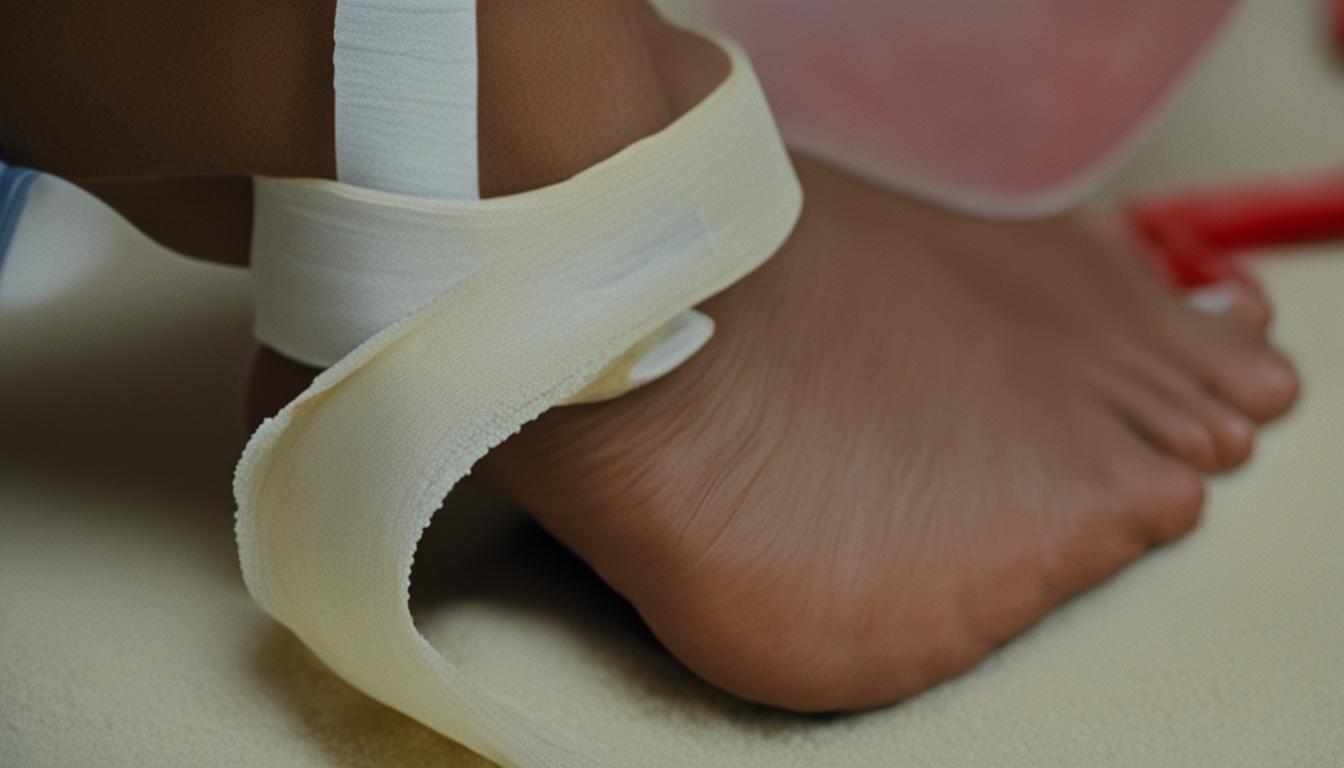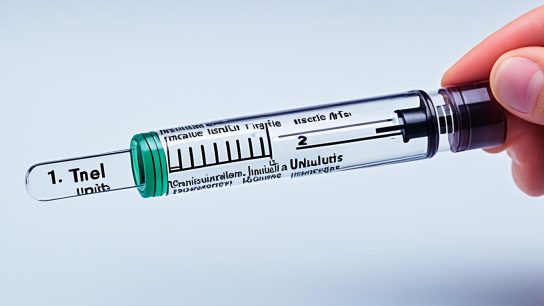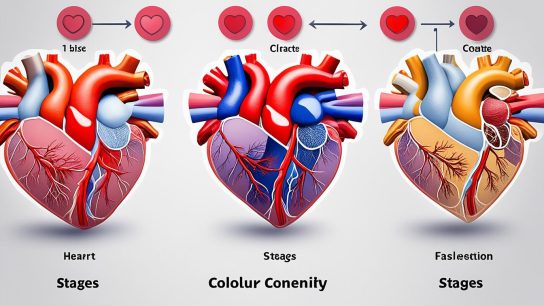Ankle sprains are a common injury that can cause pain and limited mobility. It is important to understand the healing process and recovery time for a sprained ankle.
The expected healing duration for a sprained ankle varies depending on the severity of the injury. Prompt and proper treatment is necessary to prevent chronic issues and long-term complications.
Rest, ice, compression, and elevation (RICE) are the initial steps to manage pain and swelling. Gradually returning to normal activities and incorporating range-of-motion exercises can promote healing.
If there is little improvement after one week, consulting with a healthcare professional is recommended. Further treatment options, such as immobilization, physical therapy, or surgery, may be necessary based on the severity of the sprain.
The healing process typically takes about 10 to 12 weeks for the ligament to heal, but this can vary. After the initial recovery period, wearing an ankle brace can provide added support and stability.
It is important to follow a proper rehabilitation program and engage in strengthening exercises to prevent future sprains.
Continue reading to learn more about ankle sprain severity, treatment and management, recovery and rehabilitation, prevention, when to seek medical attention, and how to expedite the healing process.
Ankle Sprain Severity and Healing Time
In order to understand how long it takes for a sprained ankle to heal, it is important to consider the severity or grade of the injury. Ankle sprains are typically classified into three grades:
- Grade 1 (Mild): This involves a partial tear of the ligament and typically takes about 3 to 5 weeks to heal.
- Grade 2 (Moderate): This involves a more significant tear of the ligament and may take around 4 to 6 weeks to heal.
- Grade 3 (Severe): This involves a complete tear of the ligament and can take anywhere from 3 to 6 months to heal.
It is essential to note that these durations are approximate and can vary based on individual factors such as age, overall health, and adherence to proper treatment and rehabilitation. The ankle sprain healing process is unique to each person, and it is crucial to consult with a healthcare professional for an accurate assessment of healing time.
Proper treatment and rehabilitation play a vital role in expediting the duration of ankle sprain healing. By following a comprehensive plan that includes rest, immobilization (if necessary), physical therapy, and a gradual return to normal activities, individuals can optimize recovery and minimize the risk of long-term complications. However, it is essential not to rush the healing process and to prioritize the body’s natural healing abilities.

Treatment and Management of Ankle Sprains
When it comes to treating ankle sprains, early intervention and proper care can significantly speed up the healing process and promote a full recovery. Here are some best practices and tips for managing ankle sprains:
The RICE Protocol
The initial treatment for an ankle sprain involves following the RICE protocol: Rest, Ice, Compression, and Elevation. These steps help reduce pain, swelling, and inflammation, allowing the healing process to begin. Here’s how you can implement the RICE protocol:
- Rest: Avoid putting weight on the injured ankle and give it time to heal. Use crutches or a walking boot if necessary.
- Ice: Apply ice packs or cold compresses to the affected area for 15-20 minutes, several times a day. This helps reduce swelling and pain.
- Compression: Use a compression sleeve or an elastic bandage to wrap the ankle snugly. This provides support and helps control swelling.
- Elevation: Elevate the injured ankle above the heart level whenever possible to minimize swelling.
Over-the-Counter Pain Medications
Over-the-counter pain medications such as ibuprofen or acetaminophen can be helpful in managing pain and inflammation. Follow the recommended dosage and consult a healthcare professional if you have any concerns.
Range-of-Motion Exercises and Gradual Return to Activities
As the pain and swelling subside, it’s essential to incorporate range-of-motion exercises to restore flexibility and prevent stiffness. Start with gentle ankle movements, such as flexing and extending the foot, and gradually progress to more challenging exercises. However, it’s crucial to listen to your body and avoid movements that cause pain or discomfort. Additionally, gradually return to normal activities as tolerated, taking breaks as needed.
Physical Therapy and Rehabilitation
In some cases, ankle sprains may require the expertise of a physical therapist. Physical therapy can help improve ankle stability, strength, and balance, reducing the risk of recurrent sprains. A qualified therapist will develop a personalized rehabilitation plan that may include exercises, manual therapy, and other modalities to facilitate healing and ensure a full recovery.
Surgical Intervention (if necessary)
Most ankle sprains can be effectively treated without surgery. However, in severe cases or when there are recurrent sprains, surgical intervention may be necessary to repair torn ligaments or address other associated injuries. Consult with an orthopedic specialist to determine the best course of action if surgery is required.
Following a Proper Treatment Plan
To optimize the healing process and prevent long-term complications, it’s vital to follow a comprehensive treatment plan recommended by a healthcare professional. This may include immobilization with braces, orthotics, or casts, along with a structured rehabilitation program. Adhering to the treatment plan diligently and attending all recommended appointments can significantly contribute to a faster and more complete recovery.

Ankle Sprain Recovery Tips
| Tips for Speeding Up Ankle Sprain Recovery |
|---|
| Follow the RICE protocol (Rest, Ice, Compression, Elevation) |
| Take over-the-counter pain medications as directed |
| Incorporate range-of-motion exercises to restore flexibility |
| Gradually return to normal activities as tolerated |
| Seek physical therapy for guided rehabilitation |
| Fully comply with the recommended treatment plan |
By following these tips and best practices, you can expedite your ankle sprain recovery and get back to your daily activities with confidence. However, remember to always consult with a healthcare professional for personalized advice and guidance throughout your recovery journey.
Recovery and Rehabilitation for Ankle Sprains
The recovery and rehabilitation process for ankle sprains involves different phases. Proper care and treatment are crucial to ensure a faster and more complete recovery. Here are some best practices and tips for ankle sprain recovery:
Phase 1: Rest, Swelling Reduction, and Protection
During the initial phase, it’s important to rest the ankle, reduce swelling, and protect the injured joint. The RICE protocol is essential:
- Rest: Avoid putting weight on the affected ankle and minimize activities that can worsen the injury.
- Ice: Apply ice wrapped in a thin cloth for 15-20 minutes every 2-3 hours to reduce swelling.
- Compression: Use a compression bandage to provide support and reduce swelling.
- Elevation: Elevate the injured ankle above the heart level to further reduce swelling.
Phase 2: Restoring Range of Motion, Strength, and Flexibility
As the swelling subsides, the focus shifts to restoring range of motion, strength, and flexibility in the ankle. This phase may involve:
- Gradually starting gentle range-of-motion exercises to improve flexibility.
- Incorporating strengthening exercises to rebuild weakened muscles and ligaments.
- Physical therapy sessions to improve balance, stability, and proprioception.
Phase 3: Preventing Future Sprains and Promoting Long-Term Stability
Once the ankle is stable and pain-free, it’s important to prevent future sprains and promote long-term stability:
- Engage in proprioception training exercises that challenge the ankle’s balance and control to prevent future sprains.
- Follow a supervised exercise program provided by a healthcare professional to ensure proper technique and progression.
- Incorporate ankle-specific exercises, such as balancing, band work, and stretching, into your regular fitness routine.
Rehabilitation may also include additional treatments such as ultrasound, electrical stimulation, and non-steroidal anti-inflammatory drugs (NSAIDs) to control pain and inflammation. Remember to always consult with a healthcare professional and follow their guidance throughout the recovery and rehabilitation process.

| Phase | Goals | Actions |
|---|---|---|
| Phase 1: Rest, Swelling Reduction, and Protection | Rest the ankle Reduce swelling Protect the injured joint |
RICE protocol: Rest Ice Compression Elevation |
| Phase 2: Restoring Range of Motion, Strength, and Flexibility | Restore range of motion Improve strength and flexibility |
Gradual range-of-motion exercises Strength exercises Physical therapy |
| Phase 3: Preventing Future Sprains and Promoting Long-Term Stability | Prevent future sprains Promote long-term ankle stability |
Proprioception training Supervised exercise program Ankle-specific exercises |
Prevention of Ankle Sprains
Preventing ankle sprains is crucial, especially for individuals who are physically active or participate in sports. By taking proactive measures and following these ankle sprain prevention tips, you can significantly reduce the risk of injury and promote overall foot health.
1. Strengthen Gluteal Muscles and Core
Improving stability is key to preventing ankle sprains. Focus on strengthening your gluteal muscles and core, as these areas play a critical role in maintaining proper balance and stability.
2. Balance Exercises
Engage in balancing exercises to enhance proprioception and strengthen the muscles surrounding the ankle. Standing on one foot, performing heel-to-toe walks, or using a balance board are effective exercises that can help prevent ankle sprains.
3. Ankle-Specific Strength Training
Include ankle-specific exercises in your strength training routine. Balancing exercises, band work, and stretching exercises that target the ankle joint can improve stability and reduce the risk of sprains. Consult with a physical therapist or trainer to develop a well-rounded program tailored to your needs.
4. Avoid Uneven Surfaces
When possible, avoid walking or running on uneven, unstable surfaces. Uneven terrain increases the risk of rolling or twisting your ankle and may lead to a sprain. Stick to even, well-maintained surfaces to minimize this risk.
5. Wear Proper Footwear
Choose footwear that provides adequate support and stability for your activities. Whether you’re playing sports or going for a walk, wearing shoes that fit properly and offer ankle support can help prevent ankle sprains.
6. Be Mindful of Foot Movements
Pay attention to your foot movements, especially during activities that involve quick changes in direction or pivoting. Avoid sudden twists or rolls of the foot, as these movements can strain the ankle ligaments and lead to sprains.
By incorporating these ankle sprain prevention strategies into your lifestyle, you can reduce the risk of ankle sprains and enjoy an active, injury-free lifestyle.
When to Seek Medical Attention for Ankle Sprains
Most ankle sprains can be managed with initial home care and self-treatment measures. However, there are situations where medical attention should be sought. If there is little or no improvement after the first week of home treatment, it is advisable to consult with a healthcare professional, such as a sports medicine specialist, primary care provider, or physical therapist. Other signs that warrant medical attention include severe pain, inability to bear weight on the affected ankle, significant swelling, persistent instability, or if the sprain was a result of a high-impact injury.
A healthcare professional can perform a thorough evaluation, order imaging tests if needed, and recommend appropriate treatment options based on the severity of the sprain.
Seeking medical help for ankle sprain is crucial to ensure proper diagnosis and management, especially in cases where the sprain is severe or not responding to initial home treatment. It is always better to err on the side of caution and seek professional advice when in doubt.
In case you are unsure if your ankle sprain requires medical attention, refer to the table below for a quick reference:

| When to Seek Medical Attention for Ankle Sprains | Signs that Indicate the Need for Medical Attention |
|---|---|
| Little or no improvement after one week of home treatment | Severe pain |
| Inability to bear weight on the affected ankle | Significant swelling |
| Persistent instability | High-impact injury |
Consulting with a healthcare professional will help ensure an accurate diagnosis and appropriate treatment plan for your ankle sprain. Remember, seeking medical help for ankle sprain is important to promote proper healing and avoid potential complications.
Conclusion
Healing from a sprained ankle can take time and varies depending on the severity of the injury. Mild sprains may take a few weeks to heal, while more severe sprains may require several months. Proper treatment and rehabilitation are essential for a complete recovery.
Following the RICE protocol (rest, ice, compression, and elevation), gradually returning to normal activities, engaging in physical therapy, and strengthening exercises can promote healing and prevent long-term complications. It is important to listen to your body, seek medical attention when necessary, and take proactive measures to prevent future ankle sprains.
With patience and appropriate care, most individuals can regain full functionality and return to their normal activities after an ankle sprain. Remember that each person’s healing duration may vary, so it’s important to follow the guidance of a healthcare professional and tailor your recovery plan accordingly.




